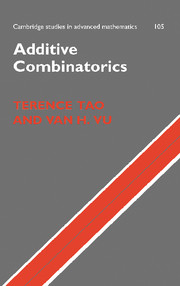Book contents
- Frontmatter
- Contents
- Prologue
- 1 The probabilistic method
- 2 Sum set estimates
- 3 Additive geometry
- 4 Fourier-analytic methods
- 5 Inverse sum set theorems
- 6 Graph-theoretic methods
- 7 The Littlewood–Offord problem
- 8 Incidence geometry
- 9 Algebraic methods
- 10 Szemerédi' theorem for k = 3
- 11 Szemerédi's theorem for k > 3
- 12 Long arithmetic progressions in sum sets
- Bibliography
- Index
Prologue
Published online by Cambridge University Press: 18 June 2010
- Frontmatter
- Contents
- Prologue
- 1 The probabilistic method
- 2 Sum set estimates
- 3 Additive geometry
- 4 Fourier-analytic methods
- 5 Inverse sum set theorems
- 6 Graph-theoretic methods
- 7 The Littlewood–Offord problem
- 8 Incidence geometry
- 9 Algebraic methods
- 10 Szemerédi' theorem for k = 3
- 11 Szemerédi's theorem for k > 3
- 12 Long arithmetic progressions in sum sets
- Bibliography
- Index
Summary
This book arose out of lecture notes developed by us while teaching courses on additive combinatorics at the University of California, Los Angeles and the University of California, San Diego. Additive combinatorics is currently a highly active area of research for several reasons, for example its many applications to additive number theory. One remarkable feature of the field is the use of tools from many diverse fields of mathematics, including elementary combinatorics, harmonic analysis, convex geometry, incidence geometry, graph theory, probability, algebraic geometry, and ergodic theory; this wealth of perspectives makes additive combinatorics a rich, fascinating, and multi-faceted subject. There are still many major problems left in the field, and it seems likely that many of these will require a combination of tools from several of the areas mentioned above in order to solve them.
The main purpose of this book is to gather all these diverse tools in one location, present them in a self-contained and introductory manner, and illustrate their application to problems in additive combinatorics. Many aspects of this material have already been covered in other papers and texts (and in particular several earlier books [168], [257], [116] have focused on some of the aspects of additive combinatorics), but this book attempts to present as many perspectives and techniques as possible in a unified setting.
Additive combinatorics is largely concerned with the additive structure1 of sets. To clarify what we mean by “additive structure”, let us introduce the following definitions.
- Type
- Chapter
- Information
- Additive Combinatorics , pp. xi - xviiiPublisher: Cambridge University PressPrint publication year: 2006

